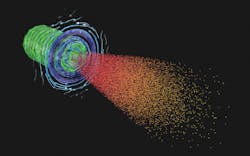Record simulation on a National Lab supercomputer
So what do you do with a computer that can carry out 16.3 quadrillion floating-point operations per second? At Lawrence Livermore National Laboratory, you simulate the interactions between ultrapowerful lasers and dense plasmas in a quest to unlock fusion energy. That simulation, a record for particle-in-code (PIC) simulations, took all of supercomputer Sequoia’s 1.5+ million cores as it tracked and displayed the simultaneous evolution of trillions of individual particles.
The simulation modeled the effects a petawatt (a million billion watts) of power from a laser flashing on and off in less than a billionth of second, heating compressed deuterium and tritium (fuel) to over 50 million°C.
The simulation ran using OSIRIS, a PIC code that uses all of Sequoia’s code in parallel. The code took 10 years to develop in a joint program between UCLA and Portugal’s Instituto Superior Tecnico. The code lets supercomputers like Sequoia do in a day what would take a medium cluster of 4,000 cores a year to complete.
Resources: Lawrence Livermore National Laboratory, www.llnl.gov

